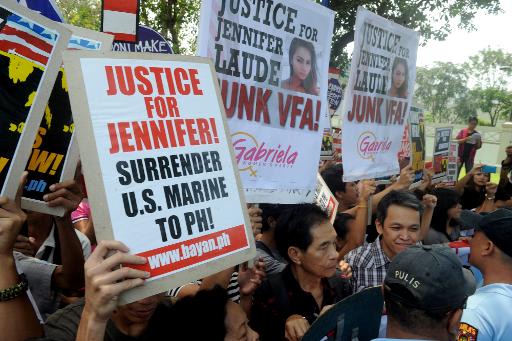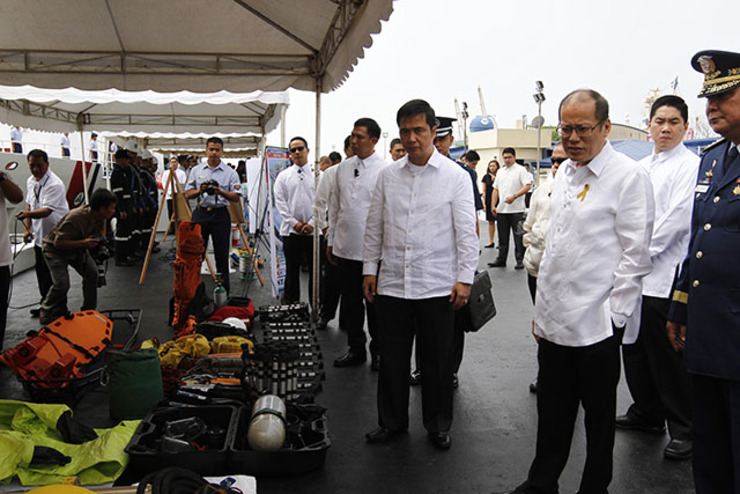PNP general a world-class inventor
By MST Business | Nov. 01, 2014 at 10:30pm
http://manilastandardtoday.com/2014/11/01/pnp-general-a-world-class-inventor/
Percival Gammad Barba, a high-ranking official of the Philippine National Police, spent his career protecting the public from crimes. With only a few weeks left before his retirement from the service, the 55-year-old father of six children now wants to use his invention to protect motorists and commuters from accidents caused by poorly lit roads.
Percival Barba shows his invention — solar-powered
road markers
Barba, who currently serves as the Philippine National Police deputy director for Western Mindanao with a rank of chief superintendent, invented the solar-powered road marker, a world-class device which was awarded a gold medal during the British Invention Show in London on Oct. 26, 2013.
A feature of modern highways, road safety devices enhance road delineation and guide vehicles at low-visibility conditions. Barba says his version of road safety devices glows at night, without using electricity from the power grid, and can supplement street lights, which are costly to build.
“This is a road safety device that we can use on our roads. I call it Barbalite solar-powered road marker. The Barbalite brand carries our name,” Barba says in an interview at the Filipino Inventors Society Producer Cooperative at Delta Building located at the corner of Quezon Ave. and West Ave. in Quezon City.
“There are different types of road safety devices, and all of them have reflectors. What makes Barbalite solar-powered road marker different is that it emits light at night. It is a self-illuminated road pavement stud. During the day, when it gathers solar power, the light turns off, and it is also a reflector on ordinary surface during the day,” he says.
“Three hours of sunlight gathered during the day are enough to power the device for the whole night. So even during the storm and rainy days, it can still gather solar energy and emit lights at night. It is also a reflector,” Barba says.
The invention, made of aluminum alloy, polycarbonate and photovoltaics, flashes red, white and yellow lights that can be seen from a distance of up to 400 meters. Twelve straight hours of flashing mode are enough to guide vehicles from dusk until dawn. Barba says the LED lights have up to 30,000 lamp hours.
Barbalite Technologies, the company established by Barba in Capas, Tarlac in 1987, was also bestowed the Filipinnovation Award by the Department of Science and Technology for excellence in electronics in 2011.
“I am turning 56 on Dec. 15. We are now shifting our focus to our invention. If the orders had pushed ahead last year, I could have retired from the service earlier. So now, on my 56th birthday, I will focus full-time on Barbalite Technologies,” he says.
Barba received a patent and copyright from the Intellectual Property Office for his invention, which also passed the rigid standards of the Department of Public Works and Highways’ Bureau of Research and Standards. The invention also received international certification from SGS, a global testing company.
Barba says the invention has the following components: a rechargeable lithium ion battery, solar panel, control board, light emitting diode and reflector. “This means it is a reflector and a road safety device as well,” he says.
Asked what led him to invent the device, Barba points to his own experience in driving at night. “The reason why I saw a need for self-illuminating road safety devices is when I was assigned as the provincial director in Pangasinan, I would go home to Fairview in Quezon City every Friday night. When I reached Fairview via Commonwealth Ave., it was difficult to drive and follow the ordinary road paints. When it rained, you could not see the lines,” he says.
“Most vehicles were using their blinkers during heavy rain at night, because the drivers could not see the road safety devices implanted on the road. Now, we have a solution,” Barba says.
Barba says the Barbalite solar-powered road marker gathers energy during the day and stores it in the battery. At night, the LED flashes and guides the motorists, he says. “We can reduce accidents at Commonwealth Ave. by installing the solar-powered road markers. The MMDA reported an average of three accidents a day at Commonwealth, especially the stretch of an elevated road divider near Technohub, which was only given a yellow-colored GI sheet,” he says.
Barba says he offered to freely install 24 pieces of solar-powered road markers at Fairview Circle as samples. “Because of what we installed, we received an order for P13.20 million worth of our devices in April. But it remains pending at the Road Board,” he says.
“It is just one of the many requests we received. We received orders from Regions 5, 9, 10 to 13, or the whole of Mindanao. We received orders for P520 million. It sounds good to the ear, but all these remain pending at the Road Board. We are still waiting for their approval and endorsement to the DBM [Department of Budget and Management]. I believe it will eventually be approved, starting with the project along Commonwealth, where accidents often occur,” he says.
“This is a solution and it is more affordable than ordinary road markers. Ordinary road markers cost P3,511.15 and they do not have lights. The Barbalite solar-powered road marker costs only P2,800,” he says.
The Barbalite device comes in three types, including those ideal for elevated dividers, the heavy-duty studs and the more affordable medium-type markers for street gutter.
Barba says the heavy-duty studs can withstand a 27-ton capacity. “It is shock-proof, water-proof and scratch-proof,” he says. He says the device has a one-year warranty. He also offers maintenance-free services.
He says aside from local district engineers, he met with officials of expressway operators. “Lately, we received calls from the Subic-Clark Tarlac Expressway. We installed 24 pieces at SCTex in Porac in December, which are still functioning well until today. Because of the free samples we installed, I think they are including us in their budget program,” he says,
Barba says with the help of banks, he can supply the P520 million worth of request all over the country. “At present, I don’t have the capacity to manufacture it here. I just spent my own money for the mold. The DOST helped us prepare the CD and video presentation, which we distributed to district engineers.”
“Many still do not know about our invention. It takes a long process in the bureaucracy, that’s why our funding also takes long. But I believe it will be eventually endorsed by the Road Board,” he says.
Barbalite Technologies’ first order came from the Porac municipal government covering 700 markers worth P1.8 million. “We installed 700 pieces of solar-powered road markers in Porac,” he says.
Barba’s interest in invention started when he was a student. Before joining the Philippine Military Academy in 1978, Barba was among the first batch of Industrial Engineering students at the Mapua Institute of Technology.
He says being an inventor was not unique in the family. His older brother, Roman Gammad Barba Jr., was a member of the Filipino Inventors Society who invented printing and laminating apparatus, a snail killer, an organic fertilizer, barcrete construction materials and other useful devices.
“I am an inventor on the side. My older brother, Roman Barba, was a full-time inventor who won many awards for his inventions from the 1960s to 2000. It was he who taught me. He is credited for many inventions, but he died a pauper. His inventions are still being used to this day. What happened to him was that he became very dependent on financiers,” he says.
“This is the predicament of Filipino inventors. We need support. But I believe that we have better prospects now. Many banks, for example, have expressed interest to finance our project. One private bank even offered to finance our capital, as long as I name the PO [purchase order] for solar-powered road markers after the bank,” he says.
“It is also faster to get a patent, as long as there is no similar innovation. One thing that will help Filipino inventors is the patronage of the public. If the solar-powered road marker will only be patronized, there are a number of jobs that will be created in the Philippines,” he says.
Barbalite Technologies currently has existing partnerships with L-Trend Optoelectronics and GreenPro Technology Inc. of Taiwan and its branch in Indonesia for the production of solar-powered road markers.
“Our dream is to establish a manufacturing plant in the Philippines. I think Subic would be a very viable site,” he says.
Barba says aside from the solar-powered marker, he is pursuing another innovation. “The mufflers of vehicles are now used to muffle or silence the sound of engine. What I am developing is something that will trap the soot [exhaust deposits], the carbon monoxide, carbon dioxide and other pollutants released into the air by cars. I now have a prototype. It has no name yet, but it is an anti-pollution filter or anti-pollution device,” he says.
Barbalite Technologies has also designed and developed other novel products and gadgets such as typhoon-proof billboard, floating garbage collector and portable hot tub.
“Now, I understand my older brother who had kept on inventing, even after successfully developing new products. So this is how an inventor feels. You are inspired to keep inventing to help other Filipinos,” he says.
Barba is a member of the Filipino Inventors Society and is among the speakers during the National Inventors Week to be held on Nov. 13 to 16 at the event center of Fisher Mall and at Delta Building in Quezon City.
Filipino Inventors Society Producer Cooperative chairman Popoy Pagayon says the National Inventors Week will showcase outstanding Filipino inventions, which are designed to help the Filipino people.
“We want to show to our nation the Filipino inventors’ talents, innovations and skills that are at par with the best of the world,” Pagayon says.
RTD
PNP general a world-class inventor - Manila Standard Today



















